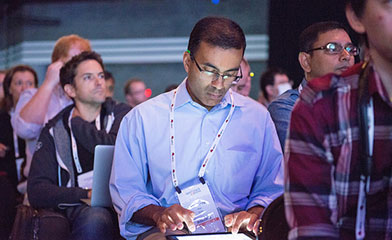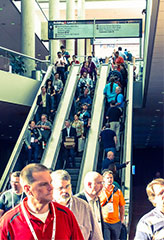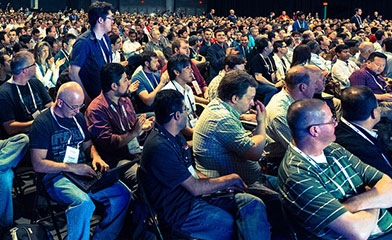Anne Gentle at the Santa Clara, CA Meetup on February 3, 2011
OpenStack Lightning Talks: Anne Gentle, Constant Stacker from OpenStack on Vimeo.

Anne Gentle at the Santa Clara, CA Meetup on February 3, 2011
OpenStack Lightning Talks: Anne Gentle, Constant Stacker from OpenStack on Vimeo.
As we take stock of the amazing interest and growth, keeping in mind the initiative’s goals and commitment to openness, the time has come to evolve the governance process to match the new reality of a larger, more diverse community. To that end, the governance process has been updated, with full details published here.
As you read through the highlights below, we encourage you to get personally involved to steer this community to an even bigger, brighter future. Whether it’s participating in a spirited debate on the mailing list, attending the bi-annual design summits, or even running for one of the elected positions, there are a lot of ways to get involved and there’s no time like the present to dive in. Nominations and elections will be held later this month for many elected positions.
Highlights:
*Upcoming Elections: As noted above, a total of 5 seats are up for election later this month, March 2011, prior to the Spring 2011 Design Summit. 3 of these will be Project Technical Leads for the respective projects, and will also sit on the Project Policy Board representing those respective communities, and 2 will be General Board Members. More details soon regarding the nomination and election process.
Again, we invite everyone to get involved and have your voice heard. If you’re interested in running for the Project Policy Board, or becoming a Project Technical Leader, now’s the time to throw your hat in the ring. Registration for the second public Design Summit will open in the next few days, in which members of the community set the roadmap and make technical decisions to drive the projects forward. You can get plugged in with our new community page at openstack.org/community.
The Xen.org community, home of the open source Xen hypervisor, announced today the availability of Xen Cloud Platform (XCP) 1.0. XCP 1.0 provides a full-featured virtualization platform solution from bare metal including the Xen hypervisor, network and storage support, and a management stack. This platform is a perfect complement to the OpenStack cloud infrastructure solution by providing the virtualization layer for a complete open source cloud stack from bare metal to cloud orchestration software.
The release of XCP 1.0 enables the Xen community to leverage the industry leading Xen hypervisor in creating a virtualization platform for the OpenStack community. Citrix Systems, a leader in the OpenStack and Xen communities, enabled not just the Xen hypervisor but also tightly integrated XCP 1.0 with OpenStack Compute and OpenStack Object Storage. This newly available joint solution provides solution providers building public and private clouds an opportunity to fully deploy a complete open source solution for their customers and employees.
Not only are the two communities actively working together to ensure a quality customer solution, but Xen.org is also taking a leading role in the governance of OpenStack with Ewan Mellor participating as a member of the OpenStack Project Oversight Committee. Ewan’s leadership role in OpenStack provides the community with an experienced open source and enterprise developer helping to guide the technology and development process.
Finally, the two projects have also submitted a joint paper proposal for OSCON 2011; “Achieving Hybrid Cloud Mobility with OpenStack and XCP” from Paul Voccio at Rackspace and Todd Deshane at Xen.org. The connection between these two open source communities is off to a great start and we look forward to more alignment in the future as open source cloud computing becomes a significant player in the industry.
You can obtain XCP 1.0 here.

Join Rackspace Hosting, the world’s leading specialist in the hosting and cloud computing industry, and OpenStack, the fastest growing open source cloud project creating the open standard cloud operating system, for some fun and arcade games! We hope to see you there, free food and drinks for all!
Kung Fu Saloon
510 Rio Grande
March 16, 2011
6pm
More information at http://schedule.sxsw.com/events/event_OE00338.

Next week, the OpenStack team and Rackspace are hosting a party on Tuesday March 8, 2011 at the Hyatt Regency Santa Clara, CA from 7:00 pm – 10:00 pm. You can register for the event at http://www.cvent.com/events/rackspace-cloud-connect-celebration/event-summary-05ddfb54276b43f88655dd0ec24f81d0.aspx.
This blog post originates from Eric Day at http://oddments.org/?p=591. I have copied it here for your reference:
OpenStack currently consists of three main components: Nova (Compute), Swift (Object Storage), and Glance (Image Service). There are some other projects such as a dashboard and mobile apps as well. You can see the full list here. This is great start, but in order for OpenStack to compete long term other infrastructure and platform services will need to be brought in. I’d like to talk about the process I’m taking with a new message queue service.
Step 1 – Idea
The first step is to figure out what is missing. What new service would compliment the software already available? What hasn’t been solved yet? What are users asking for? A message queue seemed like an appropriate next step as most applications that need to scale out and be highly available will make use of a queue at some point (sometimes not in the most obvious form). It will also allow other cloud services to be built on top of it. In fact, the current OpenStack projects could even leverage a queue service for new features.
Step 2 – Initial requirements
Before you write up a proposal and send it out, it might be a good idea to gather some initial requirements and figure out what it may look like. Don’t worry about details as the community will help flush this out later. Some of the major requirements when thinking about OpenStack projects are horizontal scalability, multi-tenancy, modular API, REST API, zones and locality awareness, and no single points of failure (high availability). This is a pretty heavy set of requirements before even getting into service specifics, but this will help you think about how to approach a service. You may have to diverge away from traditional thinking for a particular service. For example, what worked in a rack or a data center may not work in the cloud. You need to account for this up front and state behavioral differences from what folks may expect. For the queue service, this meant not taking a traditional approach you see in some queue protocols and services, and instead integrating ideas from distributed services.
A multi-tenant cloud is a very different environment from what many people are used to and usually requires a different approach to solve problems. If folks tell you you’re re-inventing the wheel, take their concerns into consideration, but also realize you may not be. You may be writing a jet engine.
Step 3 – Wiki and Mailing List Proposal
Once you have a good idea and a rough outline, you’ll probably want to run it by a couple people for feedback before sending it to everyone. You’ll then want to create a new wiki page on the OpenStack wiki and send a note to the public mailing list that mentions the wiki page and asks for community feedback. For example, the queue service proposal I wrote can be found here. There is an enormous amount of collective experience and brain power on the mailing list which will help point out any issues with the proposal. The service you initially propose may look nothing like the service you actually build. It’s also quite possible the service you propose is not a good fit for the cloud or OpenStack. The community will help iron all these details out.
Step 4 – Wait
It can take folks a while to catch up on public mailing lists, so be patient. Let people know about the proposal by other means (blog, tweet, irc, …) and help facilitate the conversation as people respond.
Step 5 – Prototype
Once you feel the community is content with the proposal and it’s a viable idea (don’t expect consensus), prototype it! This shows the community you are serious and this exercise will help work out more issues in the proposal. Let the community know about it and again wait for any feedback. This doesn’t need to be anything fancy, for the queue service I put this together over a weekend.
Step 6 – Name and Language
Now comes the difficult part, choosing a project name. I’d suggest not using the mailing list for this as it will be a lot of noise for a matter that isn’t too important. Ask a couple folks who may also be interested for ideas and make sure it’s not already taken (search on github, Launchpad, Google, etc). For the queue service we decided on “Burrow”.
You’ll also need to figure out the most appropriate language. For middleware and services, Python is a good default. If efficiency is a concern, look at Erlang or C/C++. Be sure to send another mail to the list and ask for feedback. With the queue service I initially proposed C++ with Erlang as an alternative since efficiency is a major concern (especially around utilizing multiple cores), and the community came back mixed but with more enthusiasm for Erlang.
Step 7 – Bootstrap the Project on Launchpad
We’re using Launchpad for OpenStack project management. You’ll need to create a project and a number of groups to manage it. For example, the queue project can be found here. The groups have the following roles (replace burrow with your project name):
Step 8 – Lock onto Releases and Milestone Schedule
While not important right away, it might be a good idea to start working with the OpenStack release cycle. Releases are currently every three months with milestones setup in each release for feature freeze, bug freeze, and releases. See the release page for more details. Launchpad makes it fairly simple to manage this, you’ll just want to create a new series (for example, “cactus” right now), and a couple milestones within that series for the freezing and release. Ask on the mailing list or on IRC if you need any help, but a good rule of thumb is to follow what other established projects do (like Nova).
Step 9 – Code!
Get to work and try to recruit other developers to help you. Keep the community updated with progress by using IRC, mailing list, planet.openstack.org, and tweets.
Step 10 – Submit to the Project Oversight Committee
Up until this point your project has not been an official OpenStack project. It is a well thought-out idea driven by the community that probably has a good chance though. You’ll need to make a proposal to the POC using this page once the project can stand on it’s own. You probably don’t need a final version, but you need something that is functional and more robust than a prototype. The POC meets weekly, although it may take more time (and some conversations) to decide if your project is ready. The queue service I’ve been driving has not been proposed since it’s not ready, so you may want to take all this with a grain of salt. It is my hope to have the first version ready to propose in April as part of the Cactus release.
Final Thoughts
This process will vary and can certainly be refined. I’m stating what I’ve done with a new project, but existing projects will obviously need to take a different route. The main idea to keep in mind though is that any OpenStack project should be seen as community driven, not just by an individual or company. One or more individuals may carry out a large part of the work of the community initially, but community concerns and feedback should always be taken with the utmost importance.
Here is the latest information on the upcoming OpenStack Conference / Design Summit:
Dates: April 26-29, 2011
Location: Hyatt Regency in Santa Clara, CA (http://santaclara.hyatt.com/hyatt/hotels/index.jsp?null)
Cost: $100 for all attendees; late registrations will pay $150
Event Size: 350 attendees is the maximum
The OpenStack Conference will be April 26-27, 2011 for business development, technologists and others interested in the OpenStack open source project. The OpenStack Design Summit for community developers will be April 27-29, 2011 and will consist of three days of blueprint reviews and discussions for future OpenStack releases. The agenda for both events is still in process with a list of currently submitted topics at http://etherpad.openstack.org/SubmittedTopics and working agenda at http://etherpad.openstack.org/DesignSummitApril2011. The Program Committee is currently looking at the submitted topics and fitting them into the agenda as well as recruiting more speakers/topics.
The event registration website is currently being completed and is expected to be published by the middle of the week. The registration site will also contain a link to the Hyatt Regency so attendees can take advantage of the discounted room block. If you are staying at the Hyatt, please leverage the room block as the community is required to cover the costs of all rooms not booked which could be a significant budget item.
Finally, several community participating companies have stepped up to sponsor the event and that list will be released soon. If you are interested in sponsoring, please review the current prospectus at http://www.box.net/shared/ng0r7u6n44.
If you have additional questions, want to speak at the event, or are interested in being a sponsor please contact me at [email protected].
Devin Carlen posted information to the OpenStack community on the release of a new Dashboard for OpenStack at https://lists.launchpad.net/openstack/msg01069.html. The complete posting is also reproduced here:
I’d like to take this opportunity to formally announce the Dashboard for OpenStack. It’s been available on Launchpad for a little while now so I could gather a bit of initial feedback about it. Enough people have played with it and found it useful that it makes sense to unveil it to a larger audience.
The Dashboard for OpenStack is based primarily on code that was developed for the NASA Nebula Dashboard. We received the green light to release the code under the Apache license and have done so. The project is based on Django and Python and consists of two primary pieces:
django-nova
This is a Django module that contains all of the interesting bits. It’s designed to be reusable and modular so it can be used in a variety of projects. The NASA Nebula Dashboard uses this module, as does the OpenStack Dashboard.
The repo is available at: https://launchpad.net/django-nova
As of Ubuntu Natty, it will be available in the apt repo:
http://www.ubuntuupdates.org/packages/show/302171
openstack-dashboard
This is a Django site that provides a bare minimum reference implementation around django-nova. This is essentially just CSS, django-registration for creating accounts, and the settings required to make django-nova function properly. The goal of this site is to provide something demoable with some OpenStack branding on it. Other organizations wanting to deploy a dashboard will want to roll their own, but using this as a reference.
The repo is available at: https://launchpad.net/openstack-dashboard
——
Future
——
Migrate to OpenStack API
Currently django-nova is based on the EC2 API for several reasons:
* OpenStack API lacks support for Volumes (this is being remedied very soon)
* OpenStack API has some conflicts with how project and user groups are handled.
* OpenStack API lacks admin API functions such as creating users and projects, starting VPNs.
We have cobbled together the admin functions in the EC2 based admin endpoint for now.
The goal is to transition to the OpenStack API as soon as it is possible. There’s no harm in starting this effort in a separate branch now so we can begin figuring out exactly where the pain points will be.
Combine django-nova and openstack-dashboard repos
Since these are complementary projects, I originally created them as separate Launchpad repos, but this created a lot of extra overhead when applying fixes that related to both projects. The code won’t be combined anymore than it already is, but I will be restructuring the openstack-dashboard repo to include django-nova in a separate folder. This will make it much easier to deal with.
Improve user experience
We followed an agile development process and created the minimum of what was needed as we proceeded, but for the most part the functionality has stabilized. There is room for improvement in the general usability of the sight, such as adding more client side scripting, improving layouts, etc.
There is much more to be done, but this is a good starting point for discussion!
Many people have asked for more insight into the developer activities for OpenStack as the large number of code changes and proposals make it difficult to monitor everything happening. In hopes of exposing more of the developer activities, I plan to post a weekly or biweekly blog post on the latest development activities. If you have any ideas for this blog post, please email me at [email protected]. I am always ready to listen to the community for new ideas.
Activities
• Nova 2011.1.1 release candidate available for testing – http://nova.openstack.org/tarballs/nova-2011.1.1~bzr653.tar.gz
Developer Mailing List (archive: https://lists.launchpad.net/openstack/)
• Announcing the OpenStack Dashboard – Devin Carlen announced the availability of the OpenStack Dashboard based on the NASA Nebula Dashboard. Code links at https://lists.launchpad.net/openstack/msg01069.html.
• Availability of RHEL build of Bexar release of OpenStack Nova – Grid Dynamics announced the availability of OpenStack Nova RHEL 6.0 build. The instructions to install on run on their build at http://wiki.openstack.org/NovaInstall/RHEL6Notes.
• Working on fixing code after a review? Please mark merge proposal Work in Progress – Jay Pipes commented on the backlog of code waiting for review at https://code.launchpad.net/nova/+activereviews. Jay suggests several steps for developers whose code has been reviewed with suggested code fixes. Ewan Mellor suggested that a new Wiki page be created with all the information for developers on “How Peer Reviews Work”.
• Should the OpenStack API re-use the EC2 credentials? – Justin Santa Barbara submitted a new blueprint, https://blueprints.launchpad.net/nova/+spec/authentication-consistency, to handle the authentication issues that arose between how OpenStack API and EC2 worked. More than 20 responses on this topic were posted so see https://lists.launchpad.net/openstack/msg00917.html for more information.
• Decoupling of Network and Compute Services for the new Network Service design – Ryu Ishimoto proposes a possible solution to make NOVA no longer directly dependent on the network services to allow for future “pluggable” options. More than 20 responses on this topic as well – see https://lists.launchpad.net/openstack/msg00908.html for more information.
Statistics
For the latest on development activities on OpenStack please check these sites for more details:
OpenStack Community Newsletter – February 25, 2011
This weekly newsletter is a way for the community to learn about all the various activities occurring on a weekly basis. If you would like to add content to a weekly update or have an idea about this newsletter, please email [email protected].
Coming to you 1 day early as I am flying back from Korea on Friday.

HIGHLIGHTS
EVENTS
DEVELOPER COMMUNITY
GENERAL COMMUNITY
COMMUNITY STATISTICS (2/18– 2/24)
OPENSTACK IN THE NEWS











